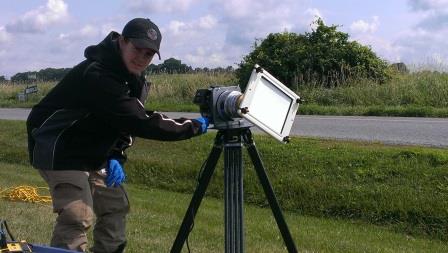FAQs: Independent Environmental Monitoring Program
April 2015
Quick Facts
- The Independent Environmental Monitoring Program (IEMP) is a planned sampling program. It does not mean that there is a problem at the nuclear facility being sampled.
- In 2014, about 200 IEMP samples were collected around 12 nuclear facilities.
- Specialized air filters are used to collect air samples. For example, a charcoal filter cartridge is used to trap radioactive iodine.
- Site-specific meteorological information and water currents are used in the unique design of a facility sampling plan.
- It takes 2 to 4 litres of water for one water sample.
- Tritium is a radioactive form of hydrogen that occurs naturally and as a by-product of nuclear operations. The IEMP measures tritium in water, air, soil, vegetation and produce.
- In addition to farmed produce, the IEMP looks at wild food, like blueberries in northern Saskatchewan.
- Q1. What is the Independent Environmental Monitoring Program?
- Q2. How does the IEMP work?
- Q3. What contaminants is the CNSC measuring?
- Q4. How often will each facility be sampled?
- Q5. Will the CNSC also test the areas within the boundaries of licensed facilities?
- Q6. Does the IEMP replace licensee monitoring programs?
- Q7. What happens if the IEMP results are different from those submitted by the licensee?
- Q8. Why would results differ between the licensee and the CNSC?
Q1. What is the Independent Environmental Monitoring Program?
A1. The Independent Environmental Monitoring Program (IEMP) is an environmental sampling initiative by the Canadian Nuclear Safety Commission (CNSC) designed to verify that public health and the environment around licensed nuclear facilities are safe.
The IEMP is separate from, but complementary to, the CNSC's existing compliance verification program. The independent sampling helps confirm that licensees' environmental protection programs are working.

CNSC staff member taking air samples in Port Hope, Ontario.
The IEMP is being put in place for facilities in all areas of the nuclear fuel cycle: uranium mines and mills, processing facilities, power plants and research reactors, as well as waste management facilities.
Q2. How does the IEMP work?
A2. CNSC staff take samples from public areas around nuclear facilities such as parks, farmland and beaches. Samples may be taken from the air, water, soil, sediment, vegetation or some local food, like meat or vegetables.
The samples are tested for contaminants at our state-of the art laboratory. We analyze them, using industry best practices. We compare the measured contaminant levels to relevant guidelines regarding safe levels in the environment. We also compare the contaminant levels to natural background levels – that is, radiation naturally present in the environment. We then publish the data on a user-friendly interactive page on the CNSC website.
Q3. What contaminants is the CNSC measuring?
A3. We look for contaminants related to the facility's operation and releases. Some of these contaminants are radiological, meaning they release radiation. For instance, as part of our program, we measure tritium and other radioactive elements such as radioactive carbon, iodine and cesium. We also monitor hazardous substances, meaning substances that do not release radiation but may still cause harm. For instance, we may monitor substances such as metals and pH levels.
Q4. How often will each facility be sampled?
A4. Over the first few years of the IEMP, we could sample each facility up to three times. This will allow us to collect enough information ̶ referred to as baseline data ̶ and to demonstrate continued protection of the environment. After this initial period, we will reduce the frequency of sampling to a periodic cycle (i.e., every two to five years). We tailor sampling and analysis to the operation of the facility. Other factors that influence the IEMP schedule include upcoming licensing hearings, instructions issued by the Commission, public concerns about a facility, previous years' monitoring results and laboratory capacity to store and process samples.

CNSC staff taking a water sample near the Pickering Nuclear Generating Station.
Q5. Will the CNSC also test the areas within the boundaries of licensed facilities?
A5. Not at this time. The IEMP investigates the environment outside of the facility, beyond the fence perimeter. The monitoring of the environment within the boundaries of licensed facilities is done as part of our regulatory compliance verification activities.
Q6. Does the IEMP replace licensee monitoring programs?
A6. No. Licensees continue to be responsible for their own environmental monitoring programs. Their monitoring results are regularly submitted to the CNSC to ensure compliance with guidelines and limits, in line with the regulations that oversee Canada's nuclear industry. We also conduct extensive compliance verification activities. This regulatory oversight includes reviews of the licensees' environmental protection programs to make sure they are adequate, as well as regular inspections to make sure the programs are being carried on properly.
Q7. What happens if the IEMP results are different from those submitted by the licensee?
A7. We consider the licensees' data when assessing the IEMP results, in order to verify that the licensee's data is within the range of what was measured in the IEMP. So, if an IEMP sample result is above the range reported by the licensee and has a potential for risk, then we will investigate further, taking the necessary action to protect public health and the environment.
Q8. Why would results differ between the licensee and the CNSC?
A8. Variations between the results of the licensee and those of the CNSC could occur for several reasons. For instance, laboratory analysis methods may be different, even if both are valid. As well, certain elements in soil and water vary naturally from one location to another. In fact, the only way two samples could ever be identical would be to sample the same material from the same location at the same time and analyze both in the same laboratory using the same methods.
Page details
- Date modified: